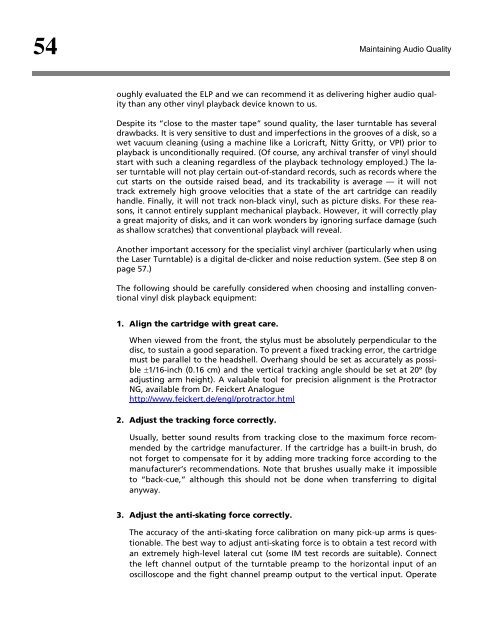Maintaining Audio Quality in the Broadcast Facility 2011 - Orban
Maintaining Audio Quality in the Broadcast Facility 2011 - Orban
Maintaining Audio Quality in the Broadcast Facility 2011 - Orban
You also want an ePaper? Increase the reach of your titles
YUMPU automatically turns print PDFs into web optimized ePapers that Google loves.
54<br />
<strong>Ma<strong>in</strong>ta<strong>in</strong><strong>in</strong>g</strong> <strong>Audio</strong> <strong>Quality</strong><br />
oughly evaluated <strong>the</strong> ELP and we can recommend it as deliver<strong>in</strong>g higher audio quality<br />
than any o<strong>the</strong>r v<strong>in</strong>yl playback device known to us.<br />
Despite its “close to <strong>the</strong> master tape” sound quality, <strong>the</strong> laser turntable has several<br />
drawbacks. It is very sensitive to dust and imperfections <strong>in</strong> <strong>the</strong> grooves of a disk, so a<br />
wet vacuum clean<strong>in</strong>g (us<strong>in</strong>g a mach<strong>in</strong>e like a Loricraft, Nitty Gritty, or VPI) prior to<br />
playback is unconditionally required. (Of course, any archival transfer of v<strong>in</strong>yl should<br />
start with such a clean<strong>in</strong>g regardless of <strong>the</strong> playback technology employed.) The laser<br />
turntable will not play certa<strong>in</strong> out-of-standard records, such as records where <strong>the</strong><br />
cut starts on <strong>the</strong> outside raised bead, and its trackability is average — it will not<br />
track extremely high groove velocities that a state of <strong>the</strong> art cartridge can readily<br />
handle. F<strong>in</strong>ally, it will not track non-black v<strong>in</strong>yl, such as picture disks. For <strong>the</strong>se reasons,<br />
it cannot entirely supplant mechanical playback. However, it will correctly play<br />
a great majority of disks, and it can work wonders by ignor<strong>in</strong>g surface damage (such<br />
as shallow scratches) that conventional playback will reveal.<br />
Ano<strong>the</strong>r important accessory for <strong>the</strong> specialist v<strong>in</strong>yl archiver (particularly when us<strong>in</strong>g<br />
<strong>the</strong> Laser Turntable) is a digital de-clicker and noise reduction system. (See step 8 on<br />
page 57.)<br />
The follow<strong>in</strong>g should be carefully considered when choos<strong>in</strong>g and <strong>in</strong>stall<strong>in</strong>g conventional<br />
v<strong>in</strong>yl disk playback equipment:<br />
1. Align <strong>the</strong> cartridge with great care.<br />
When viewed from <strong>the</strong> front, <strong>the</strong> stylus must be absolutely perpendicular to <strong>the</strong><br />
disc, to susta<strong>in</strong> a good separation. To prevent a fixed track<strong>in</strong>g error, <strong>the</strong> cartridge<br />
must be parallel to <strong>the</strong> headshell. Overhang should be set as accurately as possible<br />
�1/16-<strong>in</strong>ch (0.16 cm) and <strong>the</strong> vertical track<strong>in</strong>g angle should be set at 20º (by<br />
adjust<strong>in</strong>g arm height). A valuable tool for precision alignment is <strong>the</strong> Protractor<br />
NG, available from Dr. Feickert Analogue<br />
http://www.feickert.de/engl/protractor.html<br />
2. Adjust <strong>the</strong> track<strong>in</strong>g force correctly.<br />
Usually, better sound results from track<strong>in</strong>g close to <strong>the</strong> maximum force recommended<br />
by <strong>the</strong> cartridge manufacturer. If <strong>the</strong> cartridge has a built-<strong>in</strong> brush, do<br />
not forget to compensate for it by add<strong>in</strong>g more track<strong>in</strong>g force accord<strong>in</strong>g to <strong>the</strong><br />
manufacturer’s recommendations. Note that brushes usually make it impossible<br />
to “back-cue,” although this should not be done when transferr<strong>in</strong>g to digital<br />
anyway.<br />
3. Adjust <strong>the</strong> anti-skat<strong>in</strong>g force correctly.<br />
The accuracy of <strong>the</strong> anti-skat<strong>in</strong>g force calibration on many pick-up arms is questionable.<br />
The best way to adjust anti-skat<strong>in</strong>g force is to obta<strong>in</strong> a test record with<br />
an extremely high-level lateral cut (some IM test records are suitable). Connect<br />
<strong>the</strong> left channel output of <strong>the</strong> turntable preamp to <strong>the</strong> horizontal <strong>in</strong>put of an<br />
oscilloscope and <strong>the</strong> fight channel preamp output to <strong>the</strong> vertical <strong>in</strong>put. Operate



![[PDF] Using the ITU BS.1770-2 and CBS Loudness Meters ... - Orban](https://img.yumpu.com/50629372/1/190x245/pdf-using-the-itu-bs1770-2-and-cbs-loudness-meters-orban.jpg?quality=85)






![[PDF] Optimod-FM Feature Comparison - Orban](https://img.yumpu.com/41741615/1/190x245/pdf-optimod-fm-feature-comparison-orban.jpg?quality=85)






